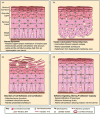Genetic pathways in disorders of epidermal differentiation
- PMID: 23141808
- PMCID: PMC5477429
- DOI: 10.1016/j.tig.2012.10.005
Genetic pathways in disorders of epidermal differentiation
Abstract
More than 100 human genetic skin diseases, impacting over 20% of the population, are characterized by disrupted epidermal differentiation. A significant proportion of the 90 genes identified in these disorders to date are concentrated within several functional pathways, suggesting the emergence of organizing themes in epidermal differentiation. Among these are the Notch, transforming growth factor β (TGFβ), IκB kinase (IKK), Ras/mitogen-activated protein kinase (MAPK), phosphoinositide 3-kinase (PI3K), p63, and Wnt signaling pathways, as well as core biological processes mediating calcium homeostasis, tissue integrity, cornification, and lipid biogenesis. Here, we review recent results supporting the central role of these pathways in epidermal differentiation, highlighting the integration of genetic information with functional studies to illuminate the biological actions of these pathways in humans as well as to guide development of future therapeutics to correct their dysfunction.
Copyright © 2012 Elsevier Ltd. All rights reserved.
Figures



References
-
- Arin MJ, et al. Identification of novel and known KRT5 and KRT14 mutations in 53 patients with epidermolysis bullosa simplex: correlation between genotype and phenotype. Br J Dermatol. 2010;162:1365–1369. - PubMed
-
- Bchetnia M, et al. Expression signature of epidermolysis bullosa simplex. Hum Genet. 2012;131:393–406. - PubMed
-
- Sawamura D, et al. Overview of epidermolysis bullosa. J Dermatol. 2010;37:214–219. - PubMed
Publication types
MeSH terms
Grants and funding
LinkOut - more resources
Full Text Sources
Other Literature Sources
Medical

